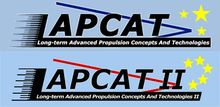LAPCAT
LAPCAT (Long-Term Advanced Propulsion Concepts and Technologies) was a 36-month European FP6 study to examine ways to produce engines for a Mach number 4-8 hypersonic flight aircraft. The project ended in April 2008.[1] It was funded by the European Commission research and development fund (rather than ESA), and cost 7 million euros.[2][3]

LAPCAT II, a 10 million euro, four-year, follow on project, started in October 2008.[1][4] The study aims to refine some of the results of the first study "allowing the definition of a detailed development roadmap" of a Mach five vehicle.[5]
Objectives
Two major technologies were to be considered:[6]
- ram-compression, which needs an additional propulsion system to achieve its minimum working speed.
- active compression, which has an upper Mach number limitation but can accelerate a vehicle up to its cruise speed.
Key objectives were the definition and evaluation of:[6]
- different propulsion cycles and concepts for high-speed flight at Mach 4 to 8 such as turbine-based and rocket-based combined cycles
- critical technologies for:
- integrated engine/aircraft performance
- mass-efficient turbines and heat-exchangers
- high-pressure and supersonic combustion experiments
- modelling
Intended results were:[6]
- definition of requirements and operational conditions for high-speed flight at system level
- dedicated experimental data-base specific to high-speed aerodynamics for supersonic and high-pressure combustion and flow phenomena.
- setting-up and validating physical models supported by numerical simulation tools to address supersonic and high-pressure combustion, turbulence and transition phenomena.
- feasibility study of weight performance turbine and heat exchanger components
Results
Among the several vehicles studied, only two novel concepts were retained for LAPCAT II: a Mach five vehicle and a Mach eight vehicle.[5]
Mach five vehicle
.jpg)
One possible supersonic transport aircraft being researched as part of this project is the A2 by Reaction Engines Limited.[7] The researchers are looking at an aircraft capable of flying from Brussels (Belgium) to Sydney (Australia) in 2–4 hours,[8] significantly reducing journey times across the globe.
To attain and maintain such high speeds, Reaction Engines Limited would need to develop its newly designed concept engine called the Scimitar, which exploits the thermodynamic properties of liquid hydrogen.[9] The engine is theoretically capable of powering the A2 to a sustained Mach 5 throughout flight with an effective exhaust velocity of 40,900 m/s or specific impulse of 4170 s, SFC 0.86 lb/(lbf⋅h).[8]
"Results so far show the Mach 5 vehicle from Reaction Engines can avoid later technology pitfalls and could travel from Brussels to Sydney," says ESA's LAPCAT project coordinator Johan Steelant.[10]
Mach eight vehicle
Although the cruise flight of the scramjet based Mach eight vehicle seems feasible, the fuel consumption during acceleration requires a large fuel fraction, severely affecting gross take-off weight. Initial studies of a first-stage rocket ejector concept gave poor range with large take-off mass.[5][11]
See also
- Precooled jet engine/Reaction Engines SABRE/Reaction Engines Scimitar
- Reaction Engines A2
- Liquid air cycle engine
- HOTOL (1986–88 design for single-stage-to-orbit reusable winged launch vehicle to use an air-breathing engine)
- Skylon (spacecraft)
References
- Steelant, J (August 2006), LAPCAT kickoff (PDF) (slides).
- Coppinger, Robert ‘Rob’ (23 October 2007). "EU to fund hypersonic civil transport research". Flight International. Flight global. Retrieved 2009-07-03.
- "LAPCAT aims at supersonic civil aviation". Gizmo Watch. 30 August 2007. Archived from the original on 20 February 2009. Retrieved 2009-07-03.
- "LAPCAT – Long-Term Advanced Propulsion Concepts and Technologies". European Commission. Archived from the original on 2009-08-05. Retrieved 2009-07-03.
- Butterworth-Hayes, Philip (June 2008). "Europe speeds up hypersonics" (PDF). Aerospace America. AIAA. Archived from the original (PDF) on 2010-03-07. Retrieved 2009-07-03.
- "LAPCAT II overview". European Space Agency. 17 November 2009. Retrieved 2010-09-21.
- "Overview: Long-Term Advanced Propulsion Concepts and Technologies". European Space Agency. 24 November 2005. Archived from the original on 18 October 2012. Retrieved 2009-07-03.
- Reaction Engines Limited - LAPCAT developers Archived 2009-07-05 at the Wayback Machine
- "LAPCAT: Long-Term Advanced Propulsion Concepts and Technologies". Reaction Engines Limited. Archived from the original on 2009-07-05. Retrieved 2009-07-03.
- "LAPCAT - Scimitar Engine". Reaction Engines Limited. Archived from the original on 2009-07-06. Retrieved 2009-07-03.
- Coppinger, Robert ‘Rob’ (15 June 2006). "EU €7m hypersonic research plan considers UK-designed Mach 5 aircraft to fly Brussels to Sydney in 2h". Flight International. Retrieved 2009-07-03.
- A conceptual design of a Dorsal-Type Mach 8 vehicle produced by the study (JPEG) (image), ESA, Dec 5, 2008.